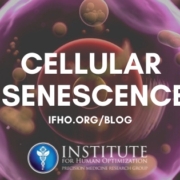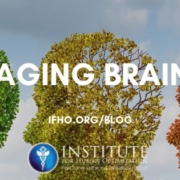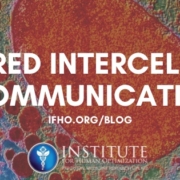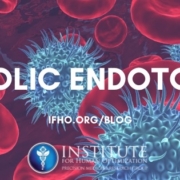Why We Get Old: The Nine Hallmarks of Aging
On the Institute for Human Optimization blog this week, we discuss the hallmarks of aging as described in the groundbreaking paper published by Carlos Lopez-Otin in 2013. It is important to understand that though these are normal changes the body goes through as it ages, we can take active steps to increase our health spans and allow these processes to happen more slowly. Here, we layout the difference between your chronological age and biological age, the nine hallmarks of aging and, a new technology that changes the way we look at the aging process.

How old are you, anyway?
Your age is not just the number of days, months, and years you’ve existed. There are two ways to think about your age: chronologically and biologically.
Your chronological age is an easy-to-determine figure as it is based on the number of years that have passed since you were born. It is characterized by age-related milestones and benchmarks that are celebrated with the passage of time. Your biological age, also referred to as phenotypic age, on the other hand, is based on lifestyle, genetics, physical and mental functions among many other factors. It is influenced by signals, inputs, and information that your body has been exposed to throughout your life.
Lifestyle factors such as poor nutrition, alcoholism, smoking, inactivity, insomnia, and stress to name a few can increase your biological age, influencing your genes and causing the effects of aging to happen faster. Depending on your lifestyle and genetics your biological age can be much higher (or lower) than your chronological age.
While chronological aging is inevitable, biological aging is manageable and even reversible. It is also possible to be a 50-year-old person with a younger biological age due to a more active, healthy lifestyle. In contrast, it’s also possible to be a 50-year-old person with a younger biological age due to a more active, healthy lifestyle. This was most recently demonstrated in Dr. Gregory Fahey’s research publication that demonstrated a Reversal of epigenetic aging and immunosenescent trends in humans published in Aging Cell in September of 2019.
There are nine hallmarks of aging.
Throughout my medical career, I’ve been fascinated by the aging mechanisms of the human body. I believe understanding the hallmarks of aging can give us an insight into what is going on inside our bodies and how we can apply that knowledge to make educated decisions about our health.
There are nine hallmarks of aging which are completely natural and will happen to all of us eventually. They are:
Genetic Instability
Damage to your DNA is happening all the time (at a rate of 10,000 to 100,000 molecular lesions per day!). Thankfully, your body has systems in place for repairing the strands and making sure your body doesn’t break down completely.
As we age, however, the repair systems become less efficient at their job which results in creating tiny chromosomal errors that add up and can eventually lead to disease. Though this happens naturally, DNA repair systems can be negatively affected by lifestyle factors such as heavy alcohol consumption or poor sleep.
Some researchers, such as David Sinclair, have been working with molecular substances such as NAD and its precursor NMN, which may help your DNA repairers stay working for longer.
Telomere Attrition
Telomeres are little caps on the end of your chromosomes that protect your genetic data. Each time your cells divide, these telomeres get a little shorter until they wear away completely, causing genetic instability. Measuring your telomeres is how we can determine your biological age.
Many researchers have been concentrating on ways to improve telomere health, which in turn can extend people’s lifespans. RNA therapy is one method that is being discussed, though it’s still in the preliminary stages.
Epigenetic Alteration
If your genes are a CD, your epigenome is the laser that reads the information and plays the song. It has the power to turn genes on or off and controls protein production in certain cells.
As you age, environmental factors can modify your epigenome slowly, making it less effective at reading your DNA- like “skipping” on a CD. The good news is that these changes to the epigenome are not permanent so hypothetically, researchers could find a way to reverse the damage and this particular hallmark of aging.
Loss of Proteostasis
This is a decline in the quality of the proteins that keep our cells doing what they do. After decades of toxins from the environment and our food assaulting our cells, they become damaged.
Your body has a natural defense against these damaged cells called autophagy. Autophagy is essentially the body’s housekeeping program, cleaning out the old dead cells so they don’t cause problems. But over time, the housekeeper becomes less effective, resulting in a build up of “zombie cells” that can produce age-related diseases like Alzheimers and Parkinson’s.
One way to accelerate autophagy and keep that housekeeper busy is by intermittent fasting- that is, going 16 or more hours a day without consuming calories.
Deregulated Nutrient-Sensing
Your body has a built-in nutrient-sensing system that its only job is to make sure you’re eating enough healthy, nutritious foods. As you age, even these systems start to break down and have a hard time determining what you need.
Years of eating processed, unnatural foods put added stress on these nutrient sensors and cause us to age faster. Our hypothalamus can be affected, causing us to be hungrier than normal and eat too many calories, which further degrades the nutrient-sensing systems.
Calorie restriction remains one of the leading age interventions related to these systems, keeping them working and determining correctly when you’ve had enough vitamin D or need a little more C.
Mitochondrial Dysfunction
Mitochondria are commonly called the “powerhouse” of the cell. It’s where they generate the energy to carry on with their job of keeping you going. Free radical damage over time degrades the mitochondria and less energy is produced, making your cells slower and more lethargic.
This decline is most often seen first in tissues with high energy demand: the brain and heart. This is one of the reasons our mental faculties decline as we get older. This hallmark has become a major focus of anti-aging research; If we can keep our cells powered, they can keep doing their jobs for longer and keep us healthier in the process.
Cellular Senescence
To keep your body refreshed and young, your cells have to constantly divide. This is why little kids grow so fast as their cells divide at a rapid rate during developmental years and then slow down as they become adults.
The truth is, your entire body is replaced with a completely new set of cells every 7-10 years, and more important organs are replaced even faster than that. There is an inner mechanism though, that acts like a biological clock; Your cells can only divide a certain number of times.
When a cell can no longer split itself into more cells, it is called cellular senescence. Through autophagy, the body cleans these dead cells out but as we get older, our bodies stop doing this as efficiently. The senescent cells pile up, causing inflammation and a host of problems.
Researchers have been diving into the world of senolytics, a fascinating set of compounds that were found to improve autophagy in mice, making them look and act younger. Perhaps one day we can use similar substances to mimic the effect in humans.
Stem Cell Exhaustion
Stem cells are the blank slates from which all cells are created. All the other hallmarks of aging as well as environmental factors eventually lead to stem cell exhaustion. This is when the body is unable to replace stem cells that have migrated, differentiated, or died. Fewer stem cells mean less regeneration, meaning we start to show signs of getting old.
Anti-aging scientists are obsessed with rejuvenating these stem cells through various means, hoping to increase the number of stem cells in the body and keep you rejuvenated well into your golden years.
Altered Extracellular Communication
Cells need to talk to each other to make everything work properly. How well would a factory operate if no one knew what was going on with everyone else? As we age our cells start to have problems communicating with each other- this can lead them to make bad decisions about regulating our hormones, hunger signals and sleep cycles.
Keeping cells healthy and well-nourished can keep them communicating longer, which in turn will keep your body running smoothly.
These nine hallmarks of aging will be an overarching theme for the future of this blog. Since the publication of the Lopez-Otin’s report, anti-aging scientists have been able to make amazing progress towards not only increasing our chronological age but our health spans as well.
We hope to continue to educate people about what happens to our body systems as we age and provide well-researched ways to postpone these hallmarks as long as possible.
How can you find out your biological age?
Until recently, there was no way to measure a person’s biological age. We are proud to be in collaboration with TruDiagnostics, a company on the cutting edge of anti-aging research. With this new test, we can look at almost 900,000 spots on the genome, which is 425 times more data than any other test on the market! By measuring these factors, we can determine your biological age and see if our anti-aging interventions are truly making a difference.
The Institute for Human Optimization will be offering this test to patients in an attempt to inform them about what’s going on at a cellular level and base our recommendations on this personalized data.
Reference: López-Otin C, Blasco MA, Partridge L, Serrano M, Kroemer G. The hallmarks of aging. Cell. 2013; 153(60):1194–1217. https://www.ncbi.nlm.nih.gov/pmc/articles/PMC3836174/











Leave a Reply
Want to join the discussion?Feel free to contribute!